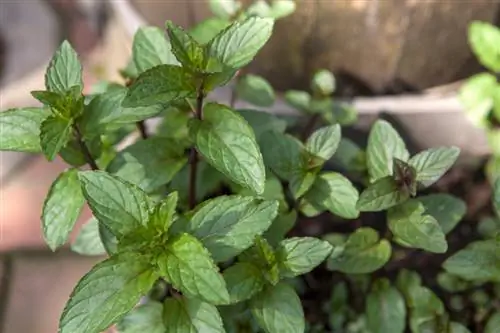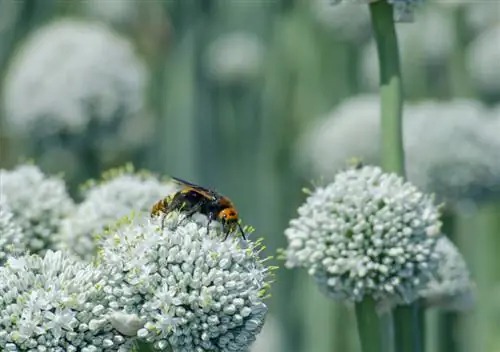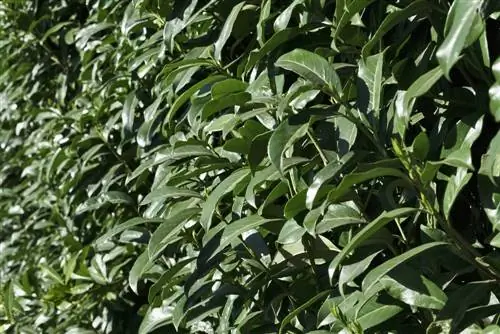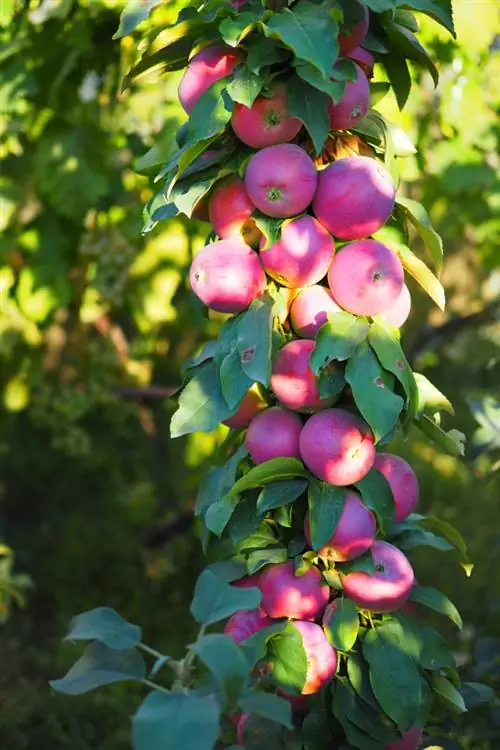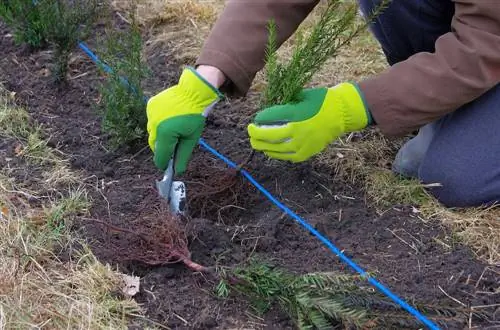- Author admin [email protected].
- Public 2023-12-16 16:46.
- Last modified 2025-01-23 11:20.
A hedge is an excellent enclosure of the property that fits into the design of the garden better than a high fence or a wall. Many garden owners want a cherry laurel hedge to border their property, as the tree is evergreen and very undemanding and quickly reaches the desired height. In this article you will find out what you need to consider when planting the row of shrubs and how to care for the hedge.
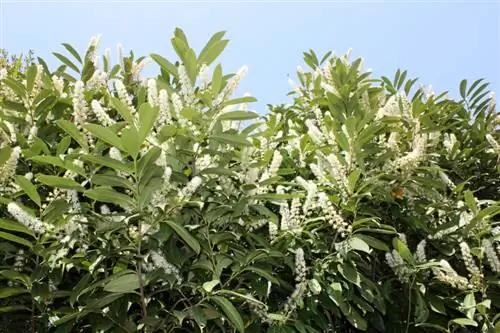
What should you consider when planting a cherry laurel hedge?
When planting a cherry laurel hedge, you should pay attention to the correct variety, minimum distances to neighboring borders and buildings, and the planting distance of the laurel cherries. In addition, soil conditions, location and planting time are crucial for the hedge's prosperity.
Choice of varieties
There are many different types of cherry laurel available in stores, so that a suitable variety can be found for almost every garden size. Since the cherry laurel is very fast-growing, species such as Etna and Caucasica, which reach a height of up to five meters, are recommended for large properties.
If you want to enclose a row house garden, which is usually very narrow, slow and slender growing species like Novita or Otto Luyken are better. For example, you can border a small garden with Genolia, which grows narrowly upright, reaches heights of up to four meters but is only about one meter wide.
Planning and creating the hedge
Take some time to plan the hedge planting, because there are a few points to consider:
Minimum distance to neighboring borders and buildings
Since the cherry laurel is a very vigorous grower, it can grow to unexpected dimensions over the years. The rule of thumb is: the tree will be approximately as wide as it is high. You should also plan a distance of around fifty centimeters from buildings and fences so that you can reach all parts of the plant when pruning.
Planting distance of the individual laurel cherries
So that the hedge grows densely in a short time, the bushes must not be placed too far apart. However, if planted too closely, the trees will crowd each other after just a few years. Depending on the height of the laurel cherries you purchase, you need to expect around three bushes per linear meter.
Soil conditions and location may require further preparation
The laurel cherry requires permeable and nutrient-rich soil for good growth. Compacted topsoil must be loosened with compost and coarse sand before planting. Take this opportunity to also mix in long-term fertilizer (€12.00 on Amazon) such as horn shavings so that the bushes are well supplied with all nutrients in the first few months.
The Planting
You need the following tools for this work:
- sharp rose scissors
- Planting spade
- measured battens as spacers
- Plant line
The best time to plant bare-root shrubs is early autumn, as the cherry laurel puts all its energy into developing the root system at the end of the growing season. Alternatively, you can plant the hedge in spring. You can bring containerized goods into the ground all year round.
Procedure for creating the hedge
- To determine the course of the hedge, first stretch a planting line
- Dig planting holes so large that the roots can easily fit in them and don't have to be stuffed in.
- The holes should be deep enough so that the top edge of the bale is flush with the surface of the earth.
- Short down damaged roots, but retain as many roots as possible.
- Insert bushes; it is helpful if a second person holds the cherry laurel.
- Tamp down the soil around the laurel cherry well so that all cavities are closed and the roots have a good connection to the ground.
Tie up the bay cherries after planting
Secure the bushes with stakes to which the bushes are carefully tied. This prevents the trees from growing at an angle and the fine roots from being torn off by winds.
Watering and mulching
After planting, you should wash the laurel cherry. This closes the last cavities and allows the cherry laurel to absorb moisture immediately. Cover the ground around each bush with a five to ten centimeter thick layer of bark mulch. This protects the earth from drying out and creates a very good soil climate.
Watering and fertilizing the cherry laurel hedge
In order to grow well, the cherry laurel hedge needs sufficient moisture. Therefore, always water the evergreen privacy screen during longer dry periods when the top few centimeters feel dry.
Fertilize the cherry laurel for the first time in the first spring after planting the hedge. An optimal supply of all nutrients and trace elements ensures that the now established cherry laurel thrives and remains he althy and resistant to pests and diseases.
The following are well suited for fertilization:
- Mature compost
- Horn shavings or horn meal
- Organic-mineral complete fertilizer, for example special fertilizer for ornamental trees
pruning
The cherry laurel hedge is also pruned for the first time in the spring after planting, ideally directly after flowering. The hedge cut at this time grows short-stemmed and very dense. If the hedge is very vigorous, a second pruning in late summer will keep the laurel cherry's growth in check. Alternatively, you can shorten the row of evergreen shrubs once a year in June or July.
Tips & Tricks
When using bare-root laurel cherries, be sure to protect the fine hair roots from drying out. It has proven useful to wrap the root balls in a damp jute sack or at least cover the roots with some damp fleece or jute.


